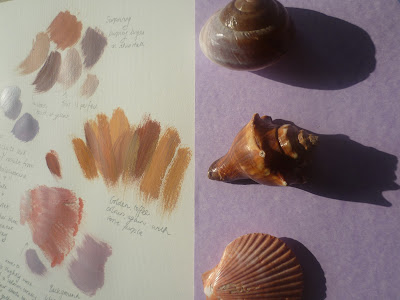In the pack were small pieces of light blue paper. All you need to do is pin it to something at the corners to make it easier to carry outside without disturbing the objects (I used a mouse mat) then put some objects on top and take it all outside to expose in the sunlight. You need to work quite quickly and have your objects ready to place as the paper can begin to expose inside. After about 2 minutes the paper turns light blue, you bring it back inside immediately then soak it in cold water for a minute and leave to dry flat. The images sharpen and darken as they dry with the object shape left in the negative.
 |
| Some of My Sun Print Experiments |
Last time I went on holiday, I decided I was going to defy those people who told me that left-handers shouldn't bother learning to crochet. However after the 4 hour plane journey I had produced a single granny triangle that was supposed to be a square and it seemed those doubters were right. My second attempt was slightly better but I still couldn't describe the shape I produced!
 |
| Attempt 2 - still very wrong! |
 |
| Tunisian Crochet - Attempt 1. I eventually worked out which hole to go into to get parallel edges. Small samples can be worked on a regular crochet hook. |
1. Make a slip knot then a chain of 10 stitches + 2 for turning chain.
2. Push the hook front to back into the third chain from the hook. (I was shown the 4th and other instructions say the 2nd so I split difference - I need to try it to see which works best). You can go through just the front, or front and back to minimise the curl. Yarn round hook and pull through so 2 stitches are on the hook.
 |
4. Wrap yarn round the hook and pull through one stitch. Wrap yarn round the hook and pull through two stitches. Continue until one stitch remains.
5. Make 1 turning chain then insert the hook from left to right into the first clear vertical bar at the front of the work (a little way in, not the bit right at the very end or the edges will be wonky like on my 1st attempt). Yarn round hook and pull through to create another stitch on the hook.
6. Push the hook behind the front of the next vertical bar from left to right, take the yarn round the hook and pull through. Repeat until you have 10 stitches on hook. (Last vertical bar is harder to identify. It appears a little lower and is at the very end of the work.)
7. Repeat steps 4-6 until you have the required length.
The back of the work looks a bit like reverse stocking stitch. The fabric produced is dense with a tendency to curl forward. (Yarn used was Patons Sorbet with a No. 7 (4.5mm) hook so the fabric would be slightly less dense with recommended 5.5mm hook.)














































